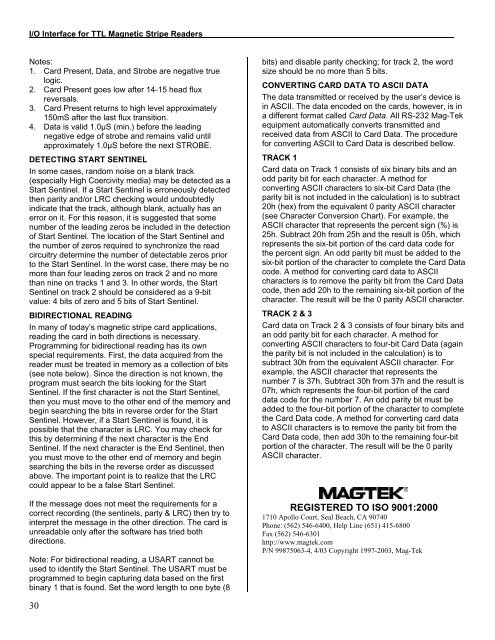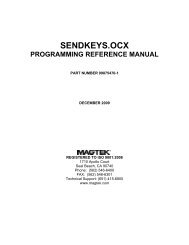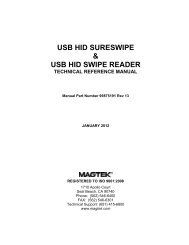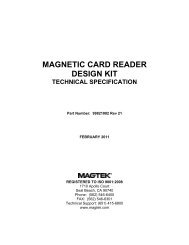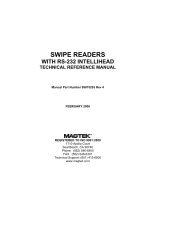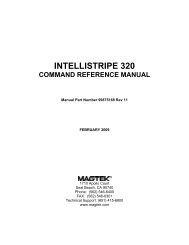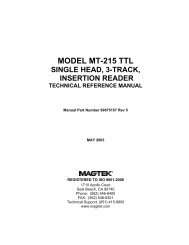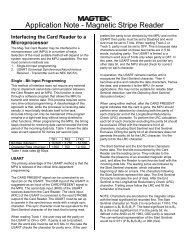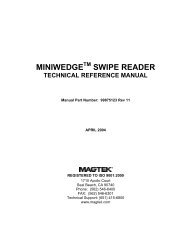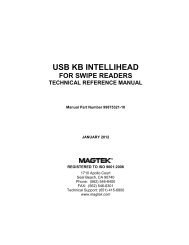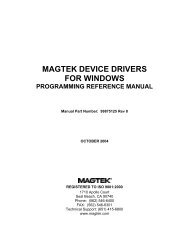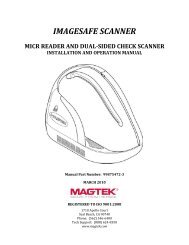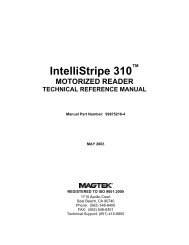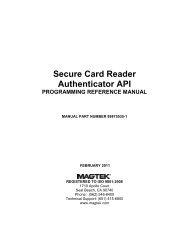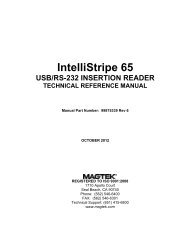I/O Interface for TTL Magnetic Stripe Readers, Technical ... - MagTek
I/O Interface for TTL Magnetic Stripe Readers, Technical ... - MagTek
I/O Interface for TTL Magnetic Stripe Readers, Technical ... - MagTek
Create successful ePaper yourself
Turn your PDF publications into a flip-book with our unique Google optimized e-Paper software.
I/O <strong>Interface</strong> <strong>for</strong> <strong>TTL</strong> <strong>Magnetic</strong> <strong>Stripe</strong> <strong>Readers</strong>Notes:1. Card Present, Data, and Strobe are negative truelogic.2. Card Present goes low after 14-15 head fluxreversals.3. Card Present returns to high level approximately150mS after the last flux transition.4. Data is valid 1.0µS (min.) be<strong>for</strong>e the leadingnegative edge of strobe and remains valid untilapproximately 1.0µS be<strong>for</strong>e the next STROBE.DETECTING START SENTINELIn some cases, random noise on a blank track(especially High Coercivity media) may be detected as aStart Sentinel. If a Start Sentinel is erroneously detectedthen parity and/or LRC checking would undoubtedlyindicate that the track, although blank, actually has anerror on it. For this reason, it is suggested that somenumber of the leading zeros be included in the detectionof Start Sentinel. The location of the Start Sentinel andthe number of zeros required to synchronize the readcircuitry determine the number of detectable zeros priorto the Start Sentinel. In the worst case, there may be nomore than four leading zeros on track 2 and no morethan nine on tracks 1 and 3. In other words, the StartSentinel on track 2 should be considered as a 9-bitvalue: 4 bits of zero and 5 bits of Start Sentinel.BIDIRECTIONAL READINGIn many of today’s magnetic stripe card applications,reading the card in both directions is necessary.Programming <strong>for</strong> bidirectional reading has its ownspecial requirements. First, the data acquired from thereader must be treated in memory as a collection of bits(see note below). Since the direction is not known, theprogram must search the bits looking <strong>for</strong> the StartSentinel. If the first character is not the Start Sentinel,then you must move to the other end of the memory andbegin searching the bits in reverse order <strong>for</strong> the StartSentinel. However, if a Start Sentinel is found, it ispossible that the character is LRC. You may check <strong>for</strong>this by determining if the next character is the EndSentinel. If the next character is the End Sentinel, thenyou must move to the other end of memory and beginsearching the bits in the reverse order as discussedabove. The important point is to realize that the LRCcould appear to be a false Start Sentinel.If the message does not meet the requirements <strong>for</strong> acorrect recording (the sentinels, party & LRC) then try tointerpret the message in the other direction. The card isunreadable only after the software has tried bothdirections.Note: For bidirectional reading, a USART cannot beused to identify the Start Sentinel. The USART must beprogrammed to begin capturing data based on the firstbinary 1 that is found. Set the word length to one byte (8bits) and disable parity checking; <strong>for</strong> track 2, the wordsize should be no more than 5 bits.CONVERTING CARD DATA TO ASCII DATAThe data transmitted or received by the user’s device isin ASCII. The data encoded on the cards, however, is ina different <strong>for</strong>mat called Card Data. All RS-232 Mag-Tekequipment automatically converts transmitted andreceived data from ASCII to Card Data. The procedure<strong>for</strong> converting ASCII to Card Data is described bellow.TRACK 1Card data on Track 1 consists of six binary bits and anodd parity bit <strong>for</strong> each character. A method <strong>for</strong>converting ASCII characters to six-bit Card Data (theparity bit is not included in the calculation) is to subtract20h (hex) from the equivalent 0 parity ASCII character(see Character Conversion Chart). For example, theASCII character that represents the percent sign (%) is25h. Subtract 20h from 25h and the result is 05h, whichrepresents the six-bit portion of the card data code <strong>for</strong>the percent sign. An odd parity bit must be added to thesix-bit portion of the character to complete the Card Datacode. A method <strong>for</strong> converting card data to ASCIIcharacters is to remove the parity bit from the Card Datacode, then add 20h to the remaining six-bit portion of thecharacter. The result will be the 0 parity ASCII character.TRACK 2 & 3Card data on Track 2 & 3 consists of four binary bits andan odd parity bit <strong>for</strong> each character. A method <strong>for</strong>converting ASCII characters to four-bit Card Data (againthe parity bit is not included in the calculation) is tosubtract 30h from the equivalent ASCII character. Forexample, the ASCII character that represents thenumber 7 is 37h. Subtract 30h from 37h and the result is07h, which represents the four-bit portion of the carddata code <strong>for</strong> the number 7. An odd parity bit must beadded to the four-bit portion of the character to completethe Card Data code. A method <strong>for</strong> converting card datato ASCII characters is to remove the parity bit from theCard Data code, then add 30h to the remaining four-bitportion of the character. The result will be the 0 parityASCII character.REGISTERED TO ISO 9001:20001710 Apollo Court, Seal Beach, CA 90740Phone: (562) 546-6400, Help Line (651) 415-6800Fax (562) 546-6301http://www.magtek.comP/N 99875063-4, 4/03 Copyright 1997-2003, Mag-Tek30


